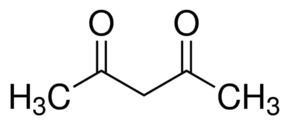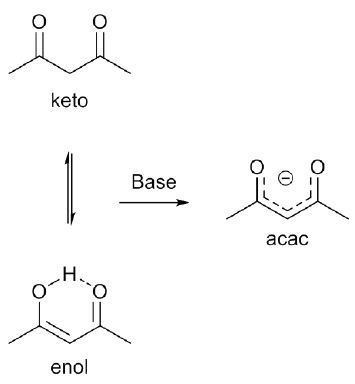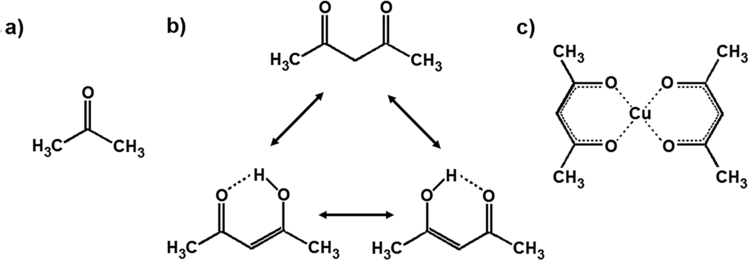Formula C5H8O2 Molar mass 100.13 g/mol | Density 980 kg/m³ Boiling point 140 °C | |
 | ||
Acetylacetone is an organic compound that exists in two tautomeric forms that interconvert rapidly and are treated as a single compound in most applications. Although the compound is formally named as the diketone form, pentane-2,4-dione, the enol form forms a substantial component of the material and is actually the favored form in many solvents. It is a colourless liquid that is a precursor to acetylacetonate (acac), a common bidentate ligand. It is also a building block for the synthesis of heterocyclic compounds.
Contents
- Tautomerism
- Acidbase properties
- Preparation
- Condensations
- Coordination chemistry
- Biodegradation
- References

Tautomerism
The keto and enol forms of acetylacetone coexist in solution; these forms are tautomers. The enol form has C2v symmetry, meaning the hydrogen atom is shared equally between the two oxygen atoms. In the gas phase, the equilibrium constant, Kketo→enol, is 11.7, favoring the enol form. The two tautomeric forms can easily be distinguished by NMR spectroscopy, IR spectroscopy, and other methods.

The equilibrium constant tends to remain high in nonpolar solvents; the keto form becomes more favorable in polar, hydrogen-bonding solvents, such as water. The enol form is a vinylogous analogue of a carboxylic acid.
Acid–base properties
Acetylacetone is a weak acid:
C5H8O2 ⇌ C5H
7O−
2 + H+

IUPAC recommended pKa values for this equilibrium in aqueous solution at 25 °C are 8.99 ± 0.04 (I = 0), 8.83 ± 0.02 (I = 0.1 M NaClO4) and 9.00 ± 0.03 (I = 1.0 M NaClO4; I = Ionic strength). Values for mixed solvents are available. Very strong bases, such as organolithium compounds, will deprotonate acetylacetone twice. The resulting dilithio species can then be alkylated at C-1.
Preparation
Acetylacetone is prepared industrially by the thermal rearrangement of isopropenyl acetate.
CH2(CH3)COC(O)Me → MeC(O)CH2C(O)MeLaboratory routes to acetylacetone begin also with acetone. Acetone and acetic anhydride upon the addition of BF3 catalyst:
(CH3CO)2O + CH3C(O)CH3 → CH3C(O)CH2C(O)CH3A second synthesis involves the base-catalyzed condensation of acetone and ethyl acetate, followed by acidification:
NaOEt + EtO2CCH3 + CH3C(O)CH3 → NaCH3C(O)CHC(O)CH3 + 2 EtOHNaCH3C(O)CHC(O)CH3 + HCl → CH3C(O)CH2C(O)CH3 + NaCl
Because of the ease of these syntheses, many analogues of acetylacetonates are known. Some examples include C6H5C(O)CH2C(O)C6H5 (dbaH) and (CH3)3CC(O)CH2C(O)CC(CH3)3. Hexafluoroacetylacetonate is also widely used to generate volatile metal complexes.
Condensations

Acetylacetone is a versatile bifunctional precursor to heterocycles because both keto groups undergo condensation. Hydrazine reacts to produce pyrazoles. Urea gives pyrimidines. Condensation with two aryl- and alkylamines to gives NacNacs, wherein the oxygen atoms in acetylacetone are replaced by NR (R = aryl, alkyl).
Coordination chemistry
The acetylacetonate anion, acac−, forms complexes with many transition metal ions. A general method of synthesis is to react the metal ion with acetylacetone in the presence of a base (B):
MBz + z Hacac ⇌ M(acac)z + z BHwhich assists the removal of a proton from acetylacetone and shifts the equilibrium in favour of the complex. Both oxygen atoms bind to the metal to form a six-membered chelate ring. In some cases the chelate effect is so strong that no added base is needed to form the complex. Since the metal complex carries no electrical charge, it is often insoluble in water but soluble in nonpolar organic solvents.
Biodegradation
Enzymatic breakdown: The enzyme acetylacetone dioxygenase cleaves the carbon-carbon bond of acetylacetone, producing acetate and 2-oxopropanal. The enzyme is iron(II)-dependent, but it has been proven to bind to zinc as well. Acetylacetone degradation has been characterized in the bacterium Acinetobacter johnsonii.
C5H8O2 + O2 → C2H4O2 + C3H4O2